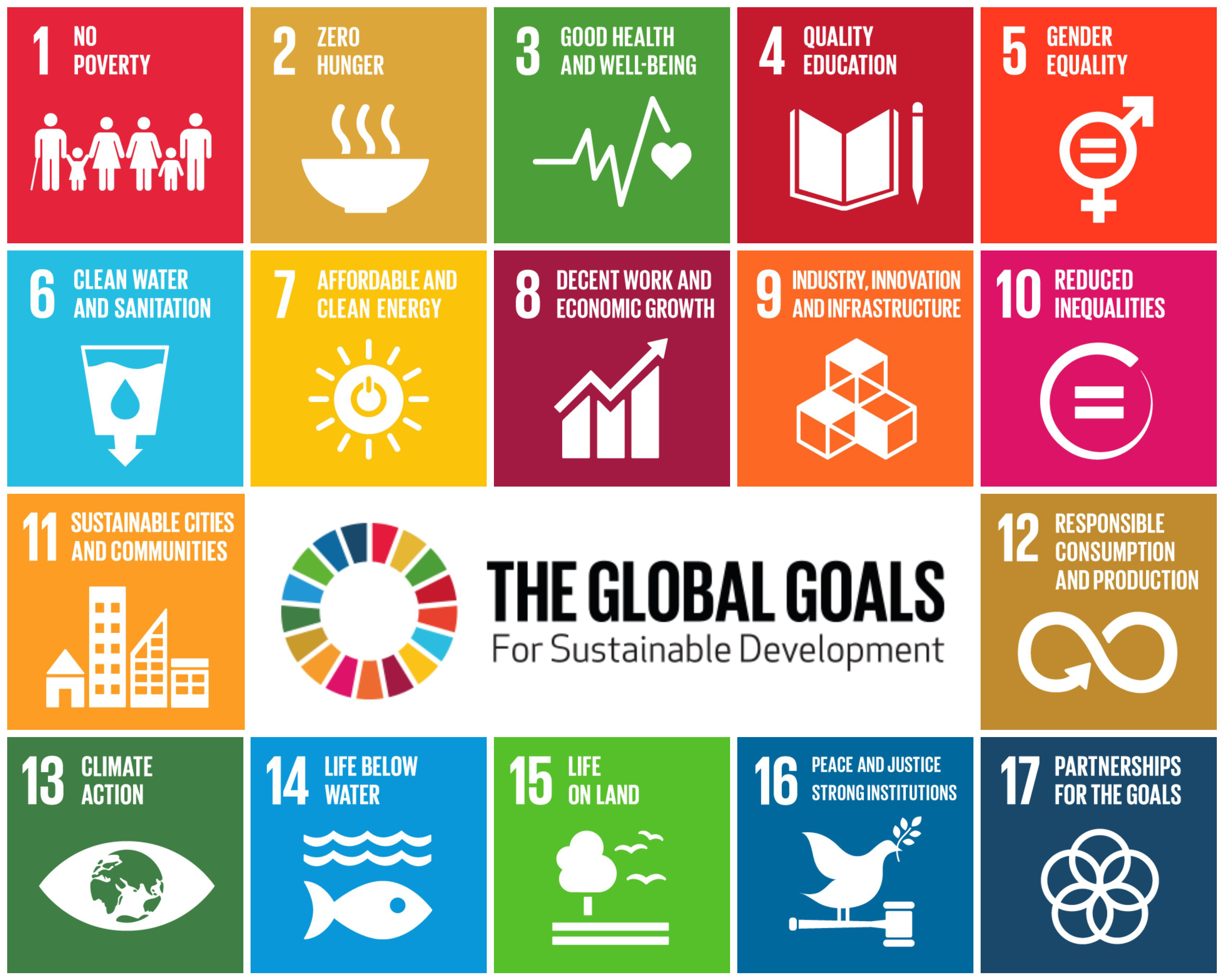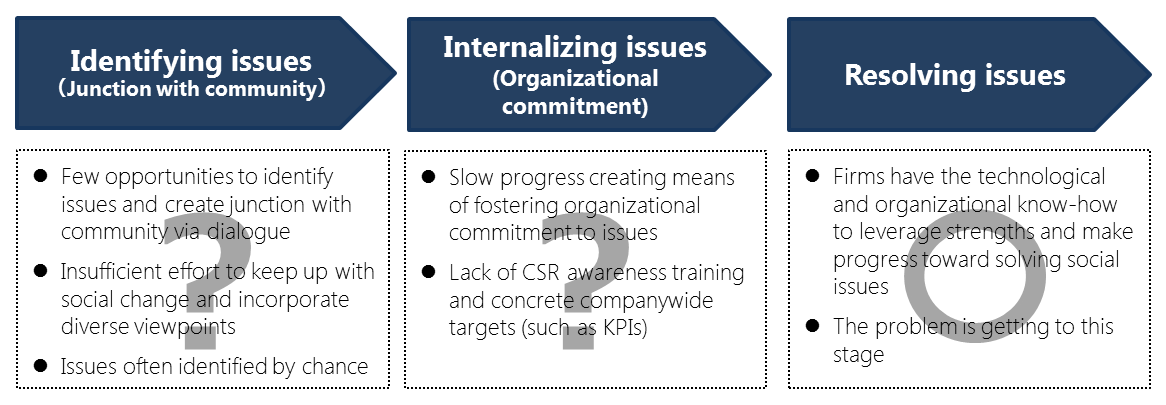
Businesses are in a unique position to utilize their resources to minimize the challenges confronting society in ways that cannot easily be undertaken by governments and private citizens. The best path to creating such a virtuous circle, notes Zentaro Kamei, is for companies to embrace CSR as the cornerstone of their management thinking and operations.
* * *
The Sustainable Development Goals, launched in January 2016, are a set of 17 goals and 169 targets that the global community seeks to achieve by 2030. [1] Unanimously adopted by the United Nations General Assembly on September 25, 2015, the SDGs were drafted after three years of deliberations on the successes and shortcomings of the Millennium Development Goals, which covered the period from 2000 to 2015.
The distinguishing feature of the SDGs is that they call on not only governments and international institutions but all players in society—private companies, nongovernmental organizations, and even individual citizens—to fulfill their “social responsibilities” by contributing to the resolution of social issues.
Like the MDGs, the post-2015 SDGs are grounded in the concept of human security. But whereas the former focused on challenges for developing countries to overcome—giving the misleading impression that they need not be addressed by governments and companies in developed countries [2] —the SDGs call on everyone, everywhere to pitch in toward the attainment of the 17 goals.

A glance at these goals shows that while the issues covered may manifest in different ways in different countries, they pose challenges for developing and developed countries alike. The need to move beyond categorization based on levels of economic development was also highlighted in the ISO 26000 guidance on social responsibility, released in 2010. The ISO guidelines outline Seven Core Subjects that users should consider (organizational governance, human rights, labor practices, environment, fair operating practices, consumer issues, and community involvement and development) and advocate Seven Key Principles of socially responsible behavior (accountability, transparency, ethical behavior, respect for stakeholder interests, respect for the rule of law, respect for international norms of behavior, and respect for human rights). The emphasis of ISO 26000 is on how , while the SDGs focus on what , enabling companies and other organizations to visualize in more concrete terms the challenges facing global society.
The Indispensable Process of Integration
The effort to raise one’s awareness of social issues through such international initiatives as the SDGs and ISO 26000 can offer valuable insights into how CSR initiatives can be integrated with the company’s core business operations.
For most private companies, the main form of interaction with society is through the sale of their products or services or via business activities that involve engaging with the public. These channels of interaction offer both opportunities for growth and the means of averting or mitigating business risks and can lead to a reaffirmation of a company’s raison d’être in society. For firms that place CSR at the heart of their operations, these activities offer a window through which society can make a whole-character appraisal of the company.
Businesses are in a unique position to utilize their technologies, organizational strengths, and global resources to minimize the challenges confronting society, to create new added value, and to otherwise contribute to society in ways that cannot easily be undertaken by governments and private citizens. The best path to creating such a virtuous circle is for companies to embrace CSR as the cornerstone of their management thinking and operations. When the task is depicted as a graph (Figure 1), the two coordinates companies should use in gauging their level of integration are degrees of “benefit to society” (contribution to the resolution of social issues) and “benefit to the company” (contribution to corporate performance). Promoting mutually beneficial activities will require a longer-term outlook and a commitment to continuity, without being preoccupied with short-term profits. In visual terms, efforts should be made to focus management resources, specific projects, and the daily activities of individual employees on the upper right square of Figure 1.
Figure 1. Resolving Social Issues through Corporate Operations

The Tokyo Foundation’s CSR White Paper 2014 and 2015 introduced a number of firms that have successfully achieved integration. While the approaches adopted differed from one company to the next—some using CSR as a framework for management, others drawing on CSR concepts to reorganize their operations, and yet others applying CSR as a consciousness-raising tool in human resources development—one common feature among all of these companies was that they were well aware of society’s needs and were actively taking steps to address them (the vertical axis in Figure 1).
Now that society’s needs are neatly encapsulated into the17 SDGs, moreover, companies need not go out of their way to ascertain them. Businesses can simply make a more conscious effort to align their management philosophy and corporate operations with those goals.
The Response of Japanese Companies
In July 2015, shortly before the adoption of the SDGs by the UN General Assembly, the Tokyo Foundation invited Director Jeffrey Sachs of the Earth Institute at Columbia University—a central figure in the task of defining of the development goals—to a public forum on CSR and the SDGs. [3] We also hosted a series of workshops in 2015 and 2016 for leading CSR companies in Japan on the likely impact of the SDGs on corporate management and the issues CSR officers were likely to face in implementing the various goals. [4] These seminars shed light on the impact the SDGs are making on corporate human resources development and the attempts being made by businesses to redesign their integration and CSR strategies.
Many companies are implementing lectures and training programs for their employees ranging from top management to the rank and file on what the SDGs entail and how they could impact on corporate operations. These programs consist not only of classroom presentations by outside experts on the specific issues addressed by the 17 goals, ways to keep abreast of society’s changing demands, and implications for market opportunities and risks but also of hands-on group work led by social entrepreneurs and civil society experts. They are designed not simply to impart new knowledge but to induce tangible changes in the way employees approach and perform their work. These opportunities for dialogue with outside experts are often an integral part of human resources development, implanting in the minds of employees the importance of viewing issues for society as challenges for themselves and their companies as well.
Of particular importance in this connection is enhancing the awareness of top executives, many of whom continue to regard CSR as the modern-day equivalent of corporate philanthropy, such as through the patronage of the arts, and thus fail to see the importance of integrating CSR into their core management strategies. Executives responsible for meeting short-term targets for performance, costs, quality, delivery, and so on to fulfill investor commitments may even be hostile to the concept of CSR.
One effective way of reforming such a mindset is participation in international conferences, such as the World Economic Forum in Davos, Switzerland. The broad range of topics covered at these meetings can give business leaders a better feel for the social issues faced by the various regions around the world that serve as their companies’ markets or are part of their global supply chains and the measures with which the issues are being addressed by governments, NGOs, and private companies. Lectures by experts alone are not enough to change the thinking of corporate managers. Far more instructive would be participation in international meetings attended by a broad cross-section of stakeholders, including those with competing viewpoints and interests. Greater familiarity with the diversity of opinions on a given topic—all of which may have some validity—can give participants a firsthand understanding of the realities of international society and the dynamics behind global conflict. Such direct exposure to the diversity of opinion can become an important asset for both executives and nonmanagerial employees, enabling them to see issues from viewpoints other than their own. New insights gained through such dialogue will also promote the development of human resources capable of spearheading the integration of corporate operations and the resolution of social issues.
Integration Revisited
An additional benefit of CSR for many companies is that it can be used as a tool for the reorientation of management priorities—called “materiality” in the parlance of CSR—in an effort to integrate the pursuit of profits with the meeting of society’s needs. Identifying material issues often involves a process that includes dialogue with stakeholders to align a company’s interests with those of greater society in various ways and at various levels, from the basic orientation of management to the training and development of human resources. [5]
Integration is a time-consuming task often requiring tortuous in-house coordination, especially when a company’s CSR program needs to be revamped. Many of the companies we surveyed for the Tokyo Foundation CSR White Paper were admittedly still in the initial stages of this process. Most were still struggling to identify confluences between the 17 SDGs and their own material issues—a task akin to positioning individual initiatives along the societal-corporate axes of Figure 1. As pointed out in our earlier white papers, many Japanese companies are wont to place action before deliberation—that is, to go ahead with initiatives before sufficiently conducting in-house deliberation on what social needs the company is in a unique position to address. This means that even in embracing the SDGs, they are merely matching the initiatives they are already undertaking to one of the 17 goals—in effect, reaffirming the status quo.
A better way of using the SDGs would be to apply their diverse perspectives—borne of extensive international dialogue—to identify areas that had remained unaddressed or that require further action in building a sustainable society.
Just because a business makes an effort to address the full range of goals outlined in the SDGs does not automatically make it a good company. But having a grasp of society’s ever-changing needs is nonetheless an important quality in ensuring business opportunities and undertaking risk management, thus helping companies to maintain and enhance their corporate value. The SDGs are important guidelines that companies can use to identify the proprietary technologies and organizational strengths that they can contribute toward sustainable development.
The 17 goals cover issues that are, at once, independent of one another and interconnected. Among the most obvious of such links are those between poverty, on the one hand, and hunger, good health, and climate change, on the other, as well as between decent work and sustainable consumption, production, and infrastructure. These issues overlap one another, making them more complicated and more difficult to address. This is all the more reason for dealing with the 17 goals not in piecemeal fashion but in an “integrated” manner. Just as with the ISO 26000 guidelines and the Global Compact, the SDGs should be used as a tool to keep abreast of society’s expectations of private businesses.
SDGs and Corporate Management
The SDGs symbolize an integrated effort to achieve sustainability by bridging the divide that had hitherto separated the developed and developing worlds. Inasmuch as the SDGs represent the collective will of international society, corporate managers should see the effort to contribute to the achievement of the sustainability goals as an opportunity to realign management priorities in ways that will better meet society’s needs. As previous Tokyo Foundation CSR White Papers have pointed out, Japanese companies are adept at applying their technological and organizational strengths to the resolution of specific social issues. On the negative side, though, they tend to be weak in identifying issues—which requires close dialogue with outside stakeholders—and in internalizing those issues so they can be addressed on a companywide basis. [6]
Figure 2. Strengths and Weaknesses of CSR in Japan

The CSR leaders in Japan have already begun moving ahead to embrace the SDGs, applying them as aids in integrating corporate operations—including human resources development—with the meeting of society’s expectations. The road ahead is clear. It is hoped that many more companies will embark on the path of closer integration, creating a virtuous cycle as they draw on their strengths to contribute to the building of a better society and thereby further enhancing their competitiveness.
[1] The Preamble of the UN document announcing the SDGs, formally titled Transforming Our World: The 2030 Agenda for Sustainable Development , reads: “This Agenda is a plan of action for people, planet and prosperity. It also seeks to strengthen universal peace in larger freedom. We recognize that eradicating poverty in all its forms and dimensions, including extreme poverty, is the greatest global challenge and an indispensable requirement for sustainable development.”
[2] Tokyo Foundation surveys have found that Japanese companies tend to have relatively low interest and initiatives in the fields of poverty, hunger, and public health.
[3] Read the article adapted from Sachs’s keynote address, “ Japan’s Role in Sustainable Development ,” on the Tokyo Foundation website.
[4] Participating companies and organizations included Ajinomoto, Akebono Brake Industry, Denso, Dentsu Inc., Fancl Corp., Fuji Xerox, Global Compact Network Japan, Itochu Corp., Kikkoman, Kirin Group, Shiseido, Sompo Japan Nipponkoa, and Takeda Pharmaceutical.
[5] See the CSR White Paper section of the Tokyo Foundation website for specific case studies.
[6] See, for example, my summary of the 2015 CSR White Paper , “ Building Responsive Companies .”
